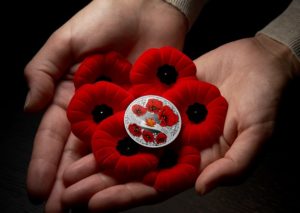
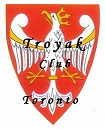
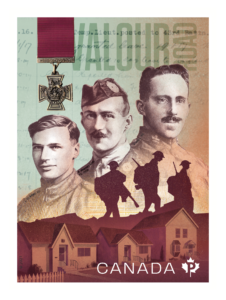
LEST WE FORGET + CZEŚĆ ICH PAMIĘCI + N’OUBLIONS PAS

TROYAK EXECUTIVE TEAM is informing all members, colleagues, collectors, and Polonia at large, that Club meetings taking place at John Paul II Polish Cultural Centre, 4300 Cawthra Rd. (just south of Hwy. 403), Mississauga, Ontario. The new members are always welcome. www.polishculturalcentre.ca
ADRES SPOTKAÑ KLUBOWYCH ! Zarząd Główny Klubu “Troyak” informuje wszystkich członków kolekcjonerów, sympatyków oraz całą Polonię, że spotkania klubowe odbywają się w Polskim Centrum Kultury im. Jana Pawła II, przy 4300 Cawthra Rd. (na południe od autostrady 403), Mississauga, Ontario. Zapraszamy nowych członków do prężnego. Klubu “Troyak”. www.polishculturalcentre.ca

“TROYAK” CLUB NEXT MEETINGS …
NASTĘPNE SPOTKANIA KLUBU “TROYAK” …
28th November 2021 @ 4:30 p.m.
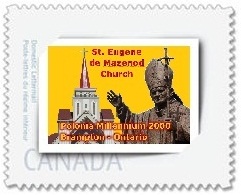
December 2021 @ Happy Holidays !

16th January 2022 @ 4:30 p.m. … Annual General Meeting
30th January 2022 @ 4:30 p.m.
27th February 2022; 27th March 2022
24th April 2022; 29th May 2022; 26th June 2022
July & August 2022 – Summer break … Letnie wakacje …


100. Rocznica urodzin Franciszka Walickiego –
ojca polskiego rock & rolla
100th Birth Anniversary of Franciszek Walicki –
the father of Polish Rock & Roll
www.poczta-polska.pl
Dnia 20 lipca 2021 r. została wprowadzona do obiegu kartka pocztowa z nadrukowanym znakiem opłaty pocztowej, emisji: “100. rocznica urodzin Franciszka Walickiego – ojca polskiego rock & rolla”. Wartość nominalna znaku opłaty pocztowej z oznaczeniem literowym A odpowiada wartości nominalnej znaczka pocztowego używanego do uiszczenia opłaty za ekonomiczną przesyłkę listową nierejestrowaną, w tym kartkę pocztową, w obrocie krajowym, w formacie S o masie do 500 g. W prawym górnym rogu strony adresowej kartki nadrukowano znak opłaty pocztowej, na którym umieszczono grafikę symbolizującą zespół muzyczny lewym górnym rogu umieszczono napis: Polska, oraz w prawym dolnym rogu oznaczenie wartości: A. W części ilustracyjnej kartki znajdują się zdjęcie Franciszka Walickiego. Kartkę o wymiarach 148 x 105 mm wydrukowano jednostronnie, techniką offsetową, na kartonie białym, w nakładzie 8000 sztuk. Autor projektu kartki: Jarosław Ochendzan.

100th Birth Anniversary of Franciszek Walicki – the father
of Polish Rock & Roll … denomination: 3,30 PLN;
number of stationeries in set: 1; print run: 8.000 pcs;
printing technique: offset; card size: 148 x 105 mm;
author: Jarosław Ochendzan; release date: 20th July 2021.

Polskie transatlantyki
Polish transatlantic ships
www.poczta-polska.pl
W dniu 23 lipca 2021 r. Poczta Polska wprowadziła do obiegu znaczki pocztowe o wartości 3,30 zł emisji “Polskie transatlantyki”. Nowa seria „Polskie transatlantyki” przedstawia wizerunki obrazów marynisty Adama Werki, na których uwidoczniono:
*** 1. Transatlantyk s/s Polonia, a wzdłuż lewej krawędzi znaczka umieszczono napis: s/s POLONIA; *** 2. Transatlantyk s/s Kościuszko, a wzdłuż lewej krawędzi znaczka umieszczono napis: s/s KOŚCIUSZKO; *** 3. Transatlantyk s/s Pułaski, a wzdłuż lewej krawędzi znaczka umieszczono napis: s/s PUŁASKI. Wzdłuż lewej krawędzi znaczków umieszczono napis: POLSKA, pod nim napis: POLSKIE TRANSATLANTYKI, a w lewym górnym rogu oznaczenie wartości: 3,30 ZŁ. Poczta Polska uzupełniła serię „Polskie transatlantyki” tematycznymi kopertami pierwszego dnia obiegu. Przedstawione są na nich poszczególne statki w obrazach Adama Werki w szacie wojennej oraz ich szkice autorstwa Marka Twardowskiego. Znaczki wydrukowano techniką offsetową, na papierze fluorescencyjnym, w formacie znaczka 76,5 x 31,25 mm, w nakładzie 140 000 szt. każdego znaczka. Arkusz zawiera 6 (2×3) znaczków.
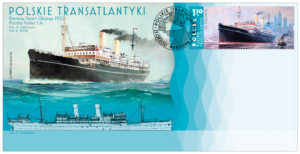
Polish transatlantic ships … denomination: 3,30 PLN;
number of stamps in set: 2; print run: 140.000 pcs. each;
printing techniques: offset; paper: fluorescent;
stamp size: 76,5 x 31,25 mm; 6 stamps in sheet;
number of FDC: 3; author: Marzanna Dąbrowska;
circulation date: 23rd July 2021.
Autorką projektów znaczków jest artystka plastyk Marzanna Dąbrowska, zaś przedstawione na nich trzy polskie przedwojenne transatlantyki: SS Polonia, SS Pułaski i SS Kościuszko, namalował marynista Adam Werka.
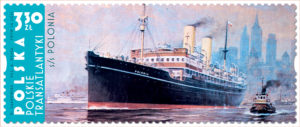
Na pierwszym znaczku uwidoczniono transatlantyk SS Polonia. Parowiec ten powstał w 1910 r. w Glasgow. Do Polski trafił w 1930 r. i użytkowany był początkowo przez spółkę Polskie Transatlantyckie Towarzystwo Okrętowe (PTTO), a następnie, od października 1934 roku, przez Gdynia-Ameryka Linie Żeglugowe SA. SS Polonia obsługiwała linię Gdynia-Kopenhaga-Halifax-Nowy Jork, a od roku 1933 tzw. linię palestyńską, kursującą na trasie Konstanca-Stambuł-Jafa-Hajfa-Pireus-Stambuł-Konstanca.

Drugi znaczek przedstawia transatlantyk SS Kościuszko. Statek ten, podobnie jak i Polonia, trafił do Polskiego Transatlantyckiego Towarzystwa Okrętowego w 1930 r. Pływał na liniach nowojorskiej, palestyńskiej i południowoamerykańskiej oraz jako wycieczkowiec. W przededniu wybuchu II Wojny Światowej został skierowany do Wielkiej Brytanii. W 1941 r. trafił pod banderę Polskiej Marynarki Wojennej, gdzie kursował jako transportowiec wojska, biorąc udział m.in. w lądowaniu na Sycylii.
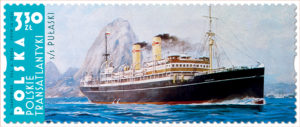
Trzecim parowcem, przedstawionym na serii znaczków „Polskie transatlantyki”, jest SS Pułaski. Pod polską banderą pływał od 1930 r. na trasie Gdynia-Nowy Jork. W 1932 roku parowiec przetransportował polską ekipę olimpijską na igrzyska w Los Angeles. Od 1936 r. jednostkę SS Pułaski przekierowano na trasę Gdynia-Buenos Aires. Po wybuchu II wojny światowej na jego pokładzie transportowani byli polscy żołnierze, internowani wcześniej na Węgrzech i Rumunii, do Francji, gdzie mogli dołączyć do formowanej tam ojczystej armii i dalej walczyć u boku aliantów.
Od ponad ćwierć wieku nie ma już polskich liniowców pasażerskich na transatlantyckich trasach – wyparły je samoloty. Biało-czerwona bandera łopotała na nich przez 57 lat. Historię polskiej, oceanicznej żeglugi pasażerskiej tworzyło dziewięć transatlantyków, kilkanaście tysięcy marynarzy i oficerów na nich pracujących. Oprócz tegorocznych trzech, Poczta Polska w następnych latach, chce pokazać kolejne 6 transatlantyków: Piłsudskiego, Batorego, Sobieskiego, Chrobrego, Jagiełłę oraz Stefana Batorego.

Rok św. Jakuba Apostoła
Year of St. Jacob the Apostle
www.poczta-polska.pl
W niedzielę, 25 lipca 2021r., Poczta Polska wprowadziła do obiegu znaczek pocztowy o wartości 4,10 zł emisji “Rok św. Jakuba Apostoła”, w dniu święta liturgicznego patrona pielgrzymów. Autorka projektu, artystka plastyk Marzanna Dąbrowska, przedstawiła na znaczku kobietę z plecakiem, do którego przymocowana została muszla św. Jakuba–symbol wszystkich pielgrzymujących do Santiago de Compostela. Wzdłuż lewej krawędzi umieszczono napis: ROK ŚW. JAKUBA APOSTOŁA, a wzdłuż górnej krawędzi napis: POLSKA i oznaczenie wartości: 4,10 zł. Znaczek wydrukowano techniką rotograwiurową, na papierze fluorescencyjnym, w formacie 25,5 x 31,25 mm, w nakładzie wielomilionowym, powtarzalnym. Arkusz sprzedażny zawiera 100 szt. znaczków.

Year of St. Jacob the Apostle … denomination: 4,10 PLN;
number of stamps in set: 1 (100 pcs in sheet);
print run: 1 000 000 pcs.; stamp size: : 25,5 x 31,25 mm;
printing techniques: photogravure; paper: fluorescent;
number of FDC: 1; author: Marzanna Dąbrowska;
circulation date: 25th July 2021.

Oprócz znaczka Poczta Polska wydała kopertę FDC (pierwszego dnia obiegu), na której przedstawiono figurę świętego Jakuba Apostoła z Bazyliki Mariackiej w Gdańsku (XV wiek) oraz mapę Europy z wybranymi szlakami pielgrzymek do Santiago de Compostela. Przy powstawaniu tej emisji Poczta Polska ściśle i owocnie współpracowała z aktywnymi ośrodkami Camino w Polsce: Domem Zakonnym Braci Mniejszych Kapucynów w Gdańsku, Archidiecezją Gdańską oraz kościołem Św. Jakuba Apostoła i zakonem oo. Dominikanów w Sandomierzu.
– Camino, czyli pielgrzymka do grobu Świętego, to niezwykła droga, istniejąca od ponad 1000 lat. Można na niej wspaniale doświadczyć, że na tej ziemi jesteśmy tylko pielgrzymami i raz rozpoczętej drogi nigdy nie kończymy. Poczta Polska wydając taki znaczek obiegowy wskazuje, że życie uczy nas pokory, wytrwałości i otwarcia na drugiego człowieka. Dokładnie tak samo jak Camino, bo życie jest drogą. Więc mówimy Buen Camino – powiedział Wiesław Włodek, wiceprezes zarządu Poczty Polskiej.
Święty Jakub Większy był jednym z 12 apostołów Jezusa Chrystusa. Poniósł męczeńską śmierć w Jerozolimie, a jego szczątki prawdopodobnie trafiły w VII wieku do Hiszpanii. Uznawany jest za patrona, m.in.: pielgrzymów, rybaków i aptekarzy. Od ponad 1000 lat postać Jakuba Apostoła przyciąga do Santiago de Compostela, w hiszpańskiej Galicji, rzesze wiernych, którzy pielgrzymują do katedry, w której prawdopodobnie znajdują się relikwie bohatera najnowszego znaczka Poczty Polskiej. Szlak tej wyjątkowej podróży religijnej, zwany Drogą świętego Jakuba, nie ma jednej trasy, a pielgrzymi mogą dotrzeć do celu jednym z wielu traktów. W Kościele zachodnim święty Jakub jest patronem, m.in.: Hiszpanii i Portugalii oraz walk z islamem.

64. Zawody o puchar Gordona Bennetta
64th Gordon Bennett Cup Competition
www.poczta-polska.pl
Dnia 6 sierpnia 2021 r. została wprowadzona do obiegu kartka pocztowa z nadrukowanym znakiem opłaty pocztowej, emisji: “64. Zawody o puchar Gordona Bennetta”. Wartość nominalna znaku opłaty pocztowej z oznaczeniem literowym A odpowiada wartości nominalnej znaczka pocztowego używanego do uiszczenia opłaty za ekonomiczną przesyłkę listową nierejestrowaną, w tym kartkę pocztową, w obrocie krajowym, w formacie S o masie do 500 g. W prawym górnym rogu strony adresowej kartki nadrukowano znak opłaty pocztowej, na którym umieszczono biało-czerwony balon, u podstawy którego, w zastępstwie kosza, jest fragment wieży ratusza staromiejskiego w Toruniu. W prawym dolnym rogu znaczka umieszczono oznaczenie wartości A, a wzdłuż górnej krawędzi – napis POLSKA. W części ilustracyjnej kartki znajduje się historyczna fotografia z 1934 r., przedstawiająca przygotowania balonów do startu na Polu Mokotowskim podczas XXII Pucharu Gordona Bennetta, tytuł emisji ,,64. Zawody o Puchar Gordona Bennetta” oraz logo tegorocznych zawodów, które będą odbywały się w Toruniu. Kartkę o wymiarach 148 x 105 mm wydrukowano jednostronnie, techniką offsetową, na kartonie białym, w nakładzie 8000 sztuk. Autor projektu kartki: Andrzej Gosik.
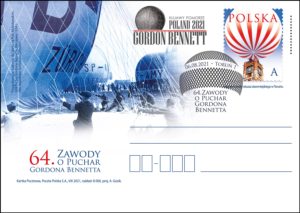
64th Gordon Bennett Cup Competition … denomination: 3,30 PLN;
number of stationeries in set: 1; print run: 8.000 pcs;
printing technique: offset; card size: 148 x 105 mm;
author: Andrzej Gosik; release date: 6th August 2021.

Święci i błogosławieni – św. Klemens Hofbauer
Saints and blesseds
www.poczta-polska.pl
W dniu 6 sierpnia 2021 r. została wprowadzona do obiegu kartka pocztowa z nadrukowanym znakiem opłaty pocztowej, emisji: “Święci i błogosławieni”. Wartość nominalna znaku opłaty pocztowej z oznaczeniem literowym A odpowiada wartości nominalnej znaczka pocztowego używanego do uiszczenia opłaty za ekonomiczną przesyłkę listową nierejestrowaną, w tym kartkę pocztową, w obrocie krajowym, w formacie S o masie do 500 g. Na znaku opłaty pocztowej umieszczono portret św. Klemensa Marii Hofbauera CSsR (1751-1820), natomiast w części ilustracyjnej kartki – fotografie dwóch warszawskich kościołów związanych z Zakonem OO. Redemptorystów: z prawej strony kościół pw. św. Benona na Nowym Mieście, gdzie przebywał św. Klemens, a z lewej strony kościół pw. św. Klemensa na Woli, obecnie kościół parafialny prowadzony przez Zakon. W centralnej części znajduję się napis: ŚWIĘCI I BŁOGOSŁAWIENI, a pod nim napis św. Klemens Maria Hofbauer (1751-1820). Kartkę o wymiarach 148 x 105 mm wydrukowano jednostronnie, techniką offsetową, na kartonie białym, w nakładzie 8000 sztuk. Autor projektu kartki: Jan Konarzewski.
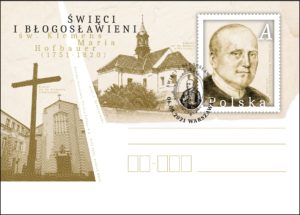
Saints and blessed … denomination: 3,30 PLN;
number of stationeries in set: 1; print run: 8.000 pcs;
printing technique: offset; card size: 148 x 105 mm;
author: Jan Konarzewski; release date: 6th August 2021.

Sztuka sakralna
Sacred art
www.poczta-polska.pl
W dniu 8 sierpnia 2021 r. została wprowadzona do obiegu kartka pocztowa z nadrukowanym znakiem opłaty pocztowej, emisji: Sztuka sakralna. Wartość nominalna znaku opłaty pocztowej z oznaczeniem literowym A odpowiada wartości nominalnej znaczka pocztowego używanego do uiszczenia opłaty za ekonomiczną przesyłkę listową nierejestrowaną, w tym kartkę pocztową, w obrocie krajowym, w formacie S o masie do 500 g. W prawym górnym rogu strony adresowej kartki nadrukowano znak opłaty pocztowej, na którym umieszczono zdjęcie mogiły powstańców styczniowych poległych w Bitwie pod Węgrowem w 1863 roku, w prawym dolnym rogu umieszczono napis: Polska oraz oznaczenie wartości: A. W części ilustracyjnej kartki znajdują się zdjęcia węgrowskich zabytków: w prawym górnym rogu – Bazyliki Mniejszej, a w prawym dolnym rogu – kościoła poreformackiego. Pomiędzy zdjęciami znajduje się napis ,,Węgrów”, a w górnej części znajduje się logotyp serii, z podpisem ,,Sztuka sakralna”. Kartkę o wymiarach 148 x 105 mm wydrukowano jednostronnie, techniką offsetową, na kartonie białym, w nakładzie 8000 sztuk. Autor projektu kartki: Jacek Konarzewski.

Sacred art … denomination: 3,30 PLN;
number of stationeries in set: 1; print run: 8.000 pcs;
printing technique: offset; card size: 148 x 105 mm;
author: Jacek Konarzewski; release date: 8th August 2021.

Edyta Stein – Święta Teresa Benedykta od Krzyża
Edith Stein – Saint Teresa Benedicta of the Cross
www.poczta-polska.pl
W dniu 9 sierpnia 2021 r. została wprowadzona do obiegu kartka pocztowa z nadrukowanym znakiem opłaty pocztowej, emisji: Edyta Stein – Święta Teresa Benedykta od Krzyża. Wartość nominalna znaku opłaty pocztowej z oznaczeniem literowym A odpowiada wartości nominalnej znaczka pocztowego używanego do uiszczenia opłaty za ekonomiczną przesyłkę listową nierejestrowaną, w tym kartkę pocztową, w obrocie krajowym, w formacie S o masie do 500 g. W prawym górnym rogu strony adresowej kartki nadrukowano znak opłaty pocztowej, na którym umieszczono fragment zdjęcia Edyty Stein w stroju zakonnym, w prawym dolnym rogu umieszczono napis: Polska, a w prawym górnym rogu oznaczenie wartości: A. W części ilustracyjnej kartki znajduje się zdjęcie Edyty Stein w stroju świeckim z napisem ,,Edyta Stein – Święta Teresa Benedykta od Krzyża” oraz cytatem z twórczości Edyty Stein. Kartkę o wymiarach 148 x 105 mm wydrukowano jednostronnie, techniką offsetową, na kartonie białym, w nakładzie 8000 sztuk. Autor projektu kartki: Bożydar Grozdew.

Edith Stein – Saint Teresa Benedicta of the Cross …
denomination: 3,30 PLN; number of stationeries in set: 1;
print run: 8.000 pcs; printing technique: offset;
card size: 148 x 105 mm; author: Bożydar Grozdew;
release date: 9th August 2021.

100. Rocznica powstania polskich związków sportowych
100th Anniversary of Polish Sports Federation
www.poczta-polska.pl
W dniu 27 sierpnia 2021 r. została wprowadzona do obiegu kartka pocztowa z nadrukowanym znakiem opłaty pocztowej, emisji: 100. rocznica powstania polskich związków sportowych. Wartość nominalna znaku opłaty pocztowej z oznaczeniem literowym A odpowiada wartości nominalnej znaczka pocztowego używanego do uiszczenia opłaty za ekonomiczną przesyłkę listową nierejestrowaną, w tym kartkę pocztową, w obrocie krajowym, w formacie S o masie do 500 g.
W prawym górnym rogu strony adresowej kartki nadrukowano znak opłaty pocztowej, na którym umieszczono piłkę do gry w tenisa. W prawym dolnym rogu znaczka umieszczono oznaczenie wartości A, a wzdłuż górnej krawędzi – napis POLSKA. W części ilustracyjnej kartki znajduje się zdjęcie wybitnej polskiej tenisistki – Agnieszki Radwańskiej na tle symbolicznego kortu tenisowego, na drugim planie zarys postaci tenisisty oraz tytuł emisji ,,100. rocznica powstania polskich związków sportowych”. W grafice datownika zamieszczono logo 100. rocznicy powstania Polskiego Związku Tenisowego.
Kartka dedykowana Polskiemu Związkowi Tenisowemu jest kontynuacją emisji “100. rocznica powstania polskich związków sportowych”, w ramach której do tej pory uhonorowane zostały Polski Związek Lekkiej Atletyki, Polski Związek Towarzystw Wioślarskich, Polski Związek Piłki Nożnej i Polski Związek Narciarski. Kartkę o wymiarach 148 x 105 mm wydrukowano jednostronnie, techniką offsetową, na kartonie białym, w nakładzie 8000 sztuk. Autor projektu kartki: Jan Konarzewski.

100th Anniversary of Polish Sports Federation …
denomination: 3,30 PLN; number of stationeries in set: 1;
print run: 8.000 pcs; printing technique: offset;
card size: 148 x 105 mm; author: Jan Konarzewski;
release date: 27th August 2021.

30. Rocznica powołania Trójkąta Weimarskiego
30th Anniversary of the Weimar Triangle
www.poczta-polska.pl
W dniu 30 sierpnia 2021 r. została wprowadzona do obiegu kartka pocztowa z nadrukowanym znakiem opłaty pocztowej, emisji: 30. rocznica powołania Trójkąta Weimarskiego. Wartość nominalna znaku opłaty pocztowej z oznaczeniem literowym A odpowiada wartości nominalnej znaczka pocztowego używanego do uiszczenia opłaty za ekonomiczną przesyłkę listową nierejestrowaną, w tym kartkę pocztową, w obrocie krajowym, w formacie S o masie do 500 g.
Na znaku opłaty pocztowej przedstawiono flagi krajów wchodzących w skład Trójkąta Weimarskiego.W lewym dolnym rogu znaczka umieszczono oznaczenie wartości A, a wzdłuż prawej krawędzi – napis POLSKA. W części ilustracyjnej kartki znajduje się symboliczny trójkąt powstały z flag państw członkowskich oraz tytuł emisji ,,30. rocznica powołania Trójkąta Weimarskiego”. Kartkę o wymiarach 148 x 105 mm wydrukowano jednostronnie, techniką offsetową, na kartonie białym, w nakładzie 8000 sztuk. Autor projektu kartki: Jan Konarzewski.
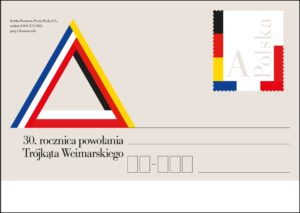
30th Anniversary of the Weimar Triangle …
denomination: 3,30 PLN; number of stationeries in set: 1;
print run: 8.000 pcs; printing technique: offset;
card size: 148 x 105 mm; author: Jan Konarzewski;
release date: 30th August 2021.

Obrona Poczty Polskiej w Gdańsku. Agresja Niemiec na Polskę
Defence of the Polish Post in Gdansk.
German aggression against Poland
www.poczta-polska.pl
W dniu 01 września 2021 r. został wprowadzony do obiegu znaczek pocztowy o wartości 3,30 zł emisji “Obrona Poczty Polskiej w Gdańsku. Agresja Niemiec na Polskę”. Na znaczku przedstawiono wizerunki obrońców urzędu pocztowego w Gdańsku: Jana Michonia, Alfonsa Flisykowskiego i Konrada Guderskiego na tle wejścia do budynku Poczty Polskiej w Gdańsku. Wzdłuż dolnej krawędzi znaczka umieszczono napis POLSKA, oznaczenie wartości: 3,30 zł oraz tytuł emisji: Obrona Poczty Polskiej w Gdańsku. Agresja Niemiec na Polskę. Znaczek wydrukowano techniką offsetową, na papierze fluorescencyjnym, w formacie znaczka 43 x 31,25 mm, w nakładzie 168.000 sztuk. Arkusz zawiera 12 znaczków. Z tej okazji została wydana również koperta FDC. Znaczek okolicznościowy Poczty Polskiej S.A. emisji ,,Obrona Poczty Polskiej w Gdańsku. Agresja Niemiec na Polskę”, zaprojektowany został na podstawie wizerunku rewersu monety NBP autorstwa Roberta Kotowicza.
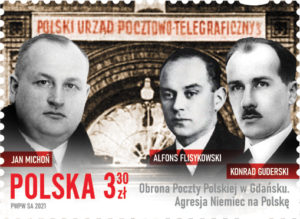
Defence of the Polish Post in Gdansk. German aggression against Poland … denomination: 3,30 PLN; number of stamps in set: 1; print run: 168.000 pcs.; printing techniques: offset; paper: fluorescent; stamp size: 43 x 31,25 x mm; 12 stamps in sheet; number of FDC: 1; author: The design was based on an image of the NBP coin reverse by Robert Kotowicz; circulation date: 1st September 2021.
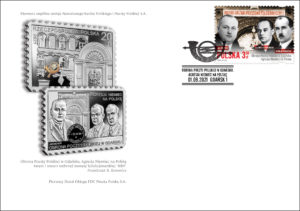
1 września 2021 r. na konferencjach Poczty Polskiej i Narodowego Banku Polskiego zaprezentowano znaczek pocztowy i kolekcjonerską monetę pod wspólną nazwą emisji „Obrona Poczty Polskiej w Gdańsku. Agresja Niemiec na Polskę”. To pierwsze w historii wspólne obchody Poczty i NBP zorganizowane w hołdzie bohaterskim Pocztowcom.
Uroczyste odsłonięcie obu walorów nastąpiło równocześnie w Warszawie, w Centrum Pieniądza NBP oraz w gdańskim Muzeum II Wojny Światowej. Jak co roku Spółka upamiętniła także poległych Pocztowców, którzy dali odpór hitlerowskiemu najeźdźcy w Wolnym Mieście, złożeniem wieńców pod Pomnikiem Obrońców Poczty Polskiej w Gdańsku. Po zmroku fasadę gmachu pocztowego, w którym przez 14 godzin bronili się Polacy, ozdobiły biało-czerwone neony i napis: „Pamiętamy 1.09.1939”.
Znaczek okolicznościowy „Obrona Poczty Polskiej w Gdańsku. Agresja Niemiec na Polskę” zaprojektowany został na kanwie wizerunku rewersu 20–złotowej kolekcjonerskiej monety, która 1 września została wyemitowana przez Narodowy Bank Polski. Autorem projektu numizmatu jest Robert Kotowicz. Na walorach na tle wejścia do gmachu przedstawiono wizerunki Obrońców Urzędu Pocztowego w Gdańsku: Jana Michonia – p.o. dyrektora Poczty Polskiej w Wolnym Mieście Gdańsku, Alfonsa Flisykowskiego, żołnierza i pocztowca, który po śmierci dowódcy obrony budynku ppor. Konrada Guderskiego, także upamiętnionego na znaczku, zawiadywał oporem. Wszyscy ci Bohaterowie ponieśli najwyższą cenę za swoje męstwo i poświęcenie. Podporucznik rezerwy piechoty Wojska Polskiego Konrad Guderski poległ w początkowej fazie walk. Jan Michoń zginął od kuli w brzuch. Alfons Flisykowski, który przez ostatnie godziny dowodził oporem w Urzędzie Pocztowo-Telegraficznym Gdańsk 1, został rozstrzelany przez Niemców po pokazowym procesie. Wszyscy obrońcy gdańskiej placówki Poczty Polskiej spoczywają na Cmentarzu Ofiar Hitleryzmu na Zaspie.
Dzięki współpracy nawiązanej z Narodowym Bankiem Polskim, po raz pierwszy miała miejsce jednoczesna emisja okolicznościowego znaczka pocztowego oraz srebrnej, kolekcjonerskiej monety o nominale 20 zł. Uroczyste prezentacje walorów odbywały się w dwóch lokalizacjach o tej samej porze – 1 września o godzinie 10:00. W Warszawie, w Centrum Pieniądza NBP, w uroczystości wzięli udział prof. Adam Glapiński, prezes Narodowego Banku Polskiego oraz prezes zarządu Poczty Polskiej S.A. – Tomasz Zdzikot. W gdańskim Muzeum II Wojny Światowej Spółkę reprezentują wiceprezesi Wiesław Włodek, Krzysztof Falkowski, Mateusz Wodejko oraz Andrzej Bodziony. Po uczestnictwie w uroczystej mszy św. w intencji poległych Pocztowców, przedstawiciele zarządu złożyli wieńce pod Pomnikiem Obrońców Poczty Polskiej.
Wydawnictwa filatelistyczne Poczty Polskiej, upamiętniające bohaterską walkę naszych rodaków, to składająca się w całość opowieść o ludziach, którzy dali przykład prawdziwego heroizmu. Emisje pocztowe ukazują polską historię w interesujący sposób. Dotyczą najróżniejszych tematów związanych z dziejami współczesnymi, dzięki czemu mogą przemówić do każdego odbiorcy. Opisują ważne wydarzenia, jak i związane z nimi postacie, co daje całościowy obraz pomocny w lepszym rozumieniu tych trudnych czasów. Atak na polski Urząd Pocztowy w Wolnym Mieście Gdańsku, obrona Westerplatte, kampania wrześniowa i niegasnąca nadzieja na szybkie zakończenie wojny. Podstępny atak Sowietów 17 września 1939 roku, sprawił, że totalitarni agresorzy wprowadzili na ziemiach polskich politykę terroru, obejmującą wszystkie warstwy społeczeństwa. Powstanie Polskiego Państwa Podziemnego, powołanie Armii Krajowej, potem Powstanie Warszawskie. O wszystkich tych wydarzeniach opowiadają znaczki pocztowe Spółki, upominając się o pamięć o Bohaterach i ucząc, że o wolność i zasady trzeba walczyć ponad wszystko.
Srebrna moneta kolekcjonerska „Obrona Poczty Polskiej w Gdańsku. Agresja Niemiec na Polskę” ma wyjątkowy kształt znaczka pocztowego z ząbkowanym rantem, a przy jej produkcji wykorzystano druk UV. Rewers przedstawia wizerunki: dr. Jana Michonia, Alfonsa Flisykowskiego i ppor. Konrada Guderskiego na tle wejścia głównego do historycznego budynku Poczty. Wejście główne ukazane na tle zniszczonej fasady budynku Poczty jest też motywem awersu monety. Całość uzupełnia symbol Poczty Polskiej.
Warto zaznaczyć, że poza tradycyjnym, uroczystym złożeniem wieńca pod Pomnikiem Obrońców Poczty Polskiej w Gdańsku, Spółka we współpracy z Narodowym Bankiem Polskim przygotowały okolicznościową wystawę. Obejrzeć ją można przed i wewnątrz historycznego gmachu pocztowego. Tegoroczne obchody, podobnie jak i rok temu, zostały wzbogacone także o specjalną iluminację. Biało-czerwone neony oraz napis „Pamiętamy 1.09.1939” rozświetlały fasadę historycznego budynku Poczty Polskiej w Gdańsku od godz. 20.00 1 września do 6.00 rano 2 września.

Beatyfikacja Kardynała Stefana Wyszyńskiego
www.nbp.pl
Narodowy Bank Polski jest centralnym bankiem państwa odpowiadającym za politykę pieniężną i stabilność cen. Jego funkcje określa Konstytucja Rzeczypospolitej Polskiej i ustawa o NBP. NBP ma wyłączne prawo emisji pieniądza. Jako bank centralny nie prowadzi rachunków bankowych obywateli, nie przyjmuje od nich lokat, nie udziela kredytów. Prowadzi natomiast obsługę budżetu państwa, a także podmiotów sektora finansów publicznych. Gromadzi rezerwy walutowe państwa i zarządza nimi. Pełni funkcję banku banków, tworząc warunki do działania systemu bankowego. Jest również jednym z najważniejszych ośrodków naukowo-analitycznych w dziedzinie ekonomii i rynków finansowych. 26 sierpnia 2021 roku Narodowy Bank Polski wprowadził do obiegu srebrną monetę o nominale 10 zł oraz złotą o nominale 100 zł „Beatyfikacja Kardynała Stefana Wyszyńskiego”.
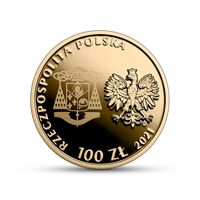
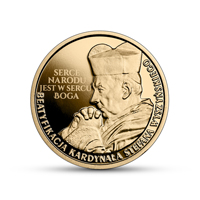
Nominał 100 zł … metal: Au 900/1000; stempel: lustrzany; średnica: 21,00 mm; masa: 8,00 g; brzeg (bok): gładki; nakład: do 1500 szt. Rewers monety złotej przedstawia popiersie Kardynała Stefana Wyszyńskiego z profilu oraz napis: SERCE NARODU JEST W SERCU BOGA, będący fragmentem wypowiedzi Kardynała.
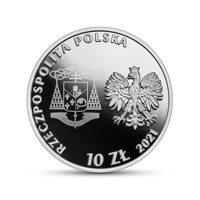
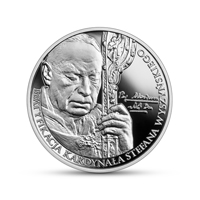
Nominał 10 zł … metal: Ag 925/1000; stempel: lustrzany; średnica: 32,00 mm; masa: 14,14 g; brzeg (bok): gładki; nakład: do 12 000 szt.; Projektant: Dobrochna Surajewska; Emitent: NBP; Na zlecenie NBP monety wyprodukowała Mennica Polska S.A. Rewers monety srebrnej przedstawia popiersie Kardynała Stefana Wyszyńskiego wspartego na pastorale oraz odręczny napis: Per Mariam – Soli Deo. Na awersach monety złotej i srebrnej przedstawiony został herb Kardynała Stefana Wyszyńskiego.
Kardynał Stefan Wyszyński (1901–1981), prymas Polski, to jedna z najważniejszych postaci XX-wiecznej historii Rzeczypospolitej. Słowem i czynem odcisnął trwały, niezatarty ślad w dziejach polskiego Kościoła, stając się autentycznym świadkiem Boga i przykładem żywej miłości do ojczyzny. Posługę prymasowską w zniewolonej ojczyźnie rozpoczął w czasie nasilenia walki władzy komunistycznej z Kościołem. W okresie stalinizmu został aresztowany i był więziony przez trzy lata w kilku miejscach odosobnienia. W tym czasie Napisał Jasnogórskie Śluby Narodu, które już po uwolnieniu prymasa stały się treścią Wielkiej Nowenny – przez dziewięć lat przygotowującej Polaków do obchodów Milenium Chrztu Polski. Odnowę duchową Polski widział prymas w kulcie maryjnym, dlatego też 3 maja 1966 roku w imieniu narodu złożył akt oddania Polski w macierzyńską niewolę miłości Maryi za wolność Kościoła w Polsce i na całym świecie.
Rocznica chrztu Polski stała się widomym świadectwem tożsamości, łączącym pokolenia Polaków na przestrzeni wieków. Prymas Wyszyński czynnie uczestniczył w pracach Soboru Watykańskiego II. Cieszył się wielkim zaufaniem papieży Jana XXIII i Pawła VI. Więzi prawdziwej przyjaźni umocniły się w relacji prymasa z kardynałem Karolem Wojtyłą, który jako Jan Paweł II dał temu wyraz w słowach: „Czcigodny i umiłowany Księże Prymasie! (…) Nie byłoby na Stolicy Piotrowej tego Papieża Polaka, który dziś pełen bojaźni Bożej, ale i pełen ufności rozpoczyna nowy pontyfikat, gdyby nie było Twojej wiary, niecofającej się przed więzieniem i cierpieniem, Twojej heroicznej nadziei, Twego zawierzenia bez reszty Matce Kościoła, gdyby nie było Jasnej Góry – i tego całego okresu dziejów Kościoła w Ojczyźnie naszej, które związane są z Twoim biskupim i prymasowskim posługiwaniem”. Prymas Wyszyński, dobry pasterz, pozostawił bogate dziedzictwo i przykład służby jako wzór szacunku do każdego człowieka, troski o jedność Kościoła i solidarność narodu. Informacja: Marta Wójcik.

Beatification of Cardinal Stefan Wyszyński
www.nbp.pl
Issuing collector items is an occasion to commemorate important historic figures and anniversaries, as well as to develop the interest of the public in Polish culture, science and tradition. Narodowy Bank Polski is the central bank of the State, responsible for its monetary policy and price stability. The Bank’s functions are described in the Constitution of the Republic of Poland and the Act on NBP. NBP holds the exclusive right to issue the currency of the Republic of Poland. As the central bank, it does not provide accounts for the general public, accept deposits from or extend loans to individuals. It acts as a banker to the State budget and public sector entities. NBP also holds and manages the foreign exchange reserves of the State. Finally, it functions as a banker to banks, creating conditions for the operation of the Polish banking system. Narodowy Bank Polski is one of the most important research and analytical centres in the fields of economics and financial markets. On 26 August 2021, Narodowy Bank Polski issued into circulation a silver coin with a face value of 10 złoty and a gold coin with a face value of 100 złoty – “Beatification of Cardinal Stefan Wyszyński”.


Face value: 100 zł … Metal: Au 900/1000; Finish: proof;
Diameter: 21.00 mm; Weight: 8.00 g; Edge (side): plain;
Mintage: up to 1,500 pcs.


Face value: 10 zł … Metal: Ag 925/1000; Finish: proof; Diameter: 32.00 mm; Weight: 14.14 g; Edge (side): plain; Mintage: up to 12,000 pcs; Designer: Dobrochna Surajewska; Issuer: NBP; The coins, commissioned by NBP, were struck by Mennica Polska S.A.
The reverse of the gold coin depicts a bust of Cardinal Stefan Wyszyński in profile and an inscription: SERCE NARODU JEST W SERCU BOGA (The nation’s heart is in God’s heart), which is a fragment of the Cardinal’s utterance. The reverse of the silver coin presents a bust of Cardinal Stefan Wyszyński leaning on a crosier, and a handwritten inscription: Per Mariam – Soli Deo. The obverse of the gold and silver coins presents the coat of arms of Cardinal Stefan Wyszyński.
Cardinal Stefan Wyszyński (1901–1981), Primate of Poland, is one of the most prominent figures in the history of 20th-century Poland. Through his word and deed, he has left a lasting and indelible mark on the history of the Polish Church. He has become a genuine God’s witness and an epitome of living love for his homeland. When Wyszyński began his primatial service in the enslaved homeland, the war waged by the Communist regime against the Church was at its height. During the Stalinism period, Wyszyński was arrested and imprisoned for three years at several places of confinement. It was at that time that the Primate wrote Jasnogórskie Śluby Narodu (The Jasna Góra Vows of the Polish Nation), which after his release from imprisonment became part of the Great Novena – a cycle of prayers that for nine years prepared Poles for the celebrations of the Millennium of the Baptism of Poland. Since the Primate believed in Poland’s spiritual renewal through the Marian cult, on 3 May 1966, he submitted – on behalf of the nation – the Act of the Consecration of Poland to Mary’s Motherly Love for the freedom of the Church in Poland and all over the world.
The anniversary of the baptism of Poland became an evident proof of national identity, uniting the generations of Poles through the centuries. Primate Wyszyński was actively involved in the work of the Second Vatican Council. He was greatly trusted by Popes John XXIII and Paul VI. Ties of true friendship developed between the Primate and Cardinal Karol Wojtyła, who, as Pope John Paul II, expressed this in the following words: “Venerable and beloved Primate, (…) This Polish Pope, full of the fear of God, but also full of trust, beginning today a new pontificate, would not be on the See of Peter if it were not for your faith, which does not shrink from prison and suffering, your heroic hope, your complete trust in the Mother of the Church if it were not for Jasna Góra – and this whole period of the history of the Church in our homeland, linked to your service as Bishop and Primate.” Primate Wyszyński, a good shepherd, has left us a rich heritage, and the example of his ministry could serve as a paragon of respect for every human being, and of concern for the unity of the Church and the solidarity of the nation. Info: Marta Wójcik.

Obrona Poczty Polskiej w Gdańsku
Agresja Niemiec na Polskę.
www.nbp.pl
Narodowy Bank Polski jest centralnym bankiem państwa odpowiadającym za politykę pieniężną i stabilność cen. Jego funkcje określa Konstytucja Rzeczypospolitej Polskiej i ustawa o NBP. NBP ma wyłączne prawo emisji pieniądza. Jako bank centralny nie prowadzi rachunków bankowych obywateli, nie przyjmuje od nich lokat, nie udziela kredytów. Prowadzi natomiast obsługę budżetu państwa, a także podmiotów sektora finansów publicznych. Gromadzi rezerwy walutowe państwa i zarządza nimi. Pełni funkcję banku banków, tworząc warunki do działania systemu bankowego. Jest również jednym z najważniejszych ośrodków naukowo-analitycznych w dziedzinie ekonomii i rynków finansowych. 1 września 2021 roku Narodowy Bank Polski wprowadził do obiegu srebrną monetę o nominale 20 zł „Obrona Poczty Polskiej w Gdańsku. Agresja Niemiec na Polskę”.
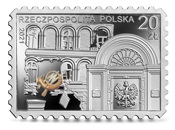
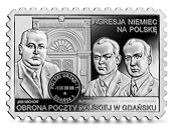
Nominał 20 zł … metal: Ag 925/1000; stempel: lustrzany, druk UV; wymiary: 40,00 × 28,00 mm; masa: 28,28 g; brzeg (bok): rant ząbkowany; nakład: do 10 000 szt.; Projektant: Robert Kotowicz; Emitent: NBP; Na zlecenie NBP monety wyprodukowała Mennica Polska S.A.
Zakończona traktatem wersalskim w 1919 r. I wojna światowa nie rozwiązała sprzeczności w relacjach polsko-niemieckich. Kością niezgody był m.in. Gdańsk, który na mocy traktatu wersalskiego z 28 czerwca 1919 r. stał się wolnym miastem. Interesy polskie zabezpieczały: Komisariat Generalny RP, Delegatura Prokuratorii Generalnej, Naczelny Inspektorat Ceł, Polskie Koleje Państwowe, Polska Delegacja Rady Portu i Dróg Wodnych, Poczta Polska, Polska Agencja Telegraficzna i in. Polska miała prawo utrzymywać oddział wartowniczy, który kwaterował na Westerplatte jako Wojskowa Składnica Tranzytowa. Mieszkająca w Gdańsku ludność polska stanowiła mniej więcej 10% ogółu mieszkańców. Nie jest jednak znana liczebność Polonii gdańskiej. Podawana jest liczba około 9000. Polacy byli narażeni na liczne szykany zarówno ze strony miejscowych władz, jak i ludności niemieckiej. 1 września 1939 r., o godz. 4.48 padły pierwsze strzały z pancernika „Schleswig-Holstein” w kierunku polskiej Wojskowej Składnicy Tranzytowej na Westerplatte. Zapoczątkowały one II wojnę światową.
Tego samego dnia zaatakowano budynek Poczty Polskiej w Wolnym Mieście Gdańsku. W ataku wziął udział oddział specjalny Schutzpolizei (Policji Ochronnej) i pododdziały SS: Wachsturmbann „Eimann” i SS-Heimwehr Danzig. Pełniącym obowiązki dyrektorem poczt i telegrafów był dr Jan Michoń, a obroną gmachu kierował ppor. rez. inż. saperów Konrad Guderski, ps. „Konrad”, pracownik cywilny Oddziału II Sztabu Głównego Wojska Polskiego. Zginął na początku obrony od wybuchu granatu i wtedy funkcję dowódcy przejął jego dotychczasowy zastępca Alfons Flisykowski. Pocztowcy stawili silny opór. Po pierwszych nieudanych atakach Niemcy wprowadzili do akcji dwa pancerne wozy: SS-Ostmark i SS-Sudetenland. Użyto ręcznych granatów i artylerii: haubicy 105 mm i dwóch dział piechoty. Pocztowcy poddali się dopiero po użyciu przez Niemców broni pancernej i miotaczy ognia. Zginęło sześciu Polaków. Aresztowanych osadzono na Biskupiej Górce, a następnie w więzieniu przy Schiesstange (ul. Kurkowa). 5 października 1939 r. na mocy bezprawnego wyroku sądu wojskowego 38 pocztowców zostało straconych na strzelnicy pomiędzy Gdańskiem-Wrzeszczem a obecną dzielnicą Zaspą. Na rewersie monety zostały przedstawione wizerunki: dr. Jana Michonia, Alfonsa Flisykowskiego oraz ppor. Konrada Guderskiego na tle wejścia głównego do budynku Poczty. Na awersie widoczne jest wejście główne do budynku Poczty Polskiej na tle jego zniszczonej fasady. Projekt uzupełnia symbol Poczty Polskiej. Informacja: Prof. zw. dr hab. Bogdan Chrzanowski.

Nominał 3,30 zł … technika druku: offset; papier: fluorescencyjny; wymiary: 43,00 × 31,25 mm; nakład: 168 000 szt.; data wprowadzenia do obiegu: 1 września 2021 r. Znaczek okolicznościowy Poczty Polskiej S.A. emisji „Obrona Poczty Polskiej w Gdańsku. Agresja Niemiec na Polskę”, zaprojektowany na podstawie wizerunku rewersu monety NBP autorstwa Roberta Kotowicza.

Defence of the Polish Post Office in Gdańsk
German Aggression Against Poland
www.nbp.pl
Issuing collector items is an occasion to commemorate important historic figures and anniversaries, as well as to develop the interest of the public in Polish culture, science and tradition. Narodowy Bank Polski is the central bank of the State, responsible for its monetary policy and price stability. The Bank’s functions are described in the Constitution of the Republic of Poland and the Act on NBP. NBP holds the exclusive right to issue the currency of the Republic of Poland. As the central bank, it does not provide accounts for the general public, accept deposits from or extend loans to individuals. It acts as a banker to the State budget and public sector entities. NBP also holds and manages the foreign exchange reserves of the State. Finally, it functions as a banker to banks, creating conditions for the operation of the Polish banking system. Narodowy Bank Polski is one of the most important research and analytical centres in the fields of economics and financial markets. On 1 September 2021, Narodowy Bank Polski issued into circulation a silver coin “Defence of the Polish Post Office in Gdańsk. German Aggression Against Poland” with a face value of 20 złoty.


Face value: 20 zł … Metal: Ag 925/1000; Finish: proof, UV printing; Dimensions: 40.00 mm × 28.00 mm; Weight: 28.28 g; Edge (side): milled; Mintage: up to 10,000 pcs.; Designer: Robert Kotowicz; Issuer: NBP; The coins, commissioned by NBP, were struck by Mennica Polska S.A.
While the Treaty of Versailles put an end to World War I in 1919, it did not resolve the contentious issues in Polish-German relations. The bone of contention was, among other matters, Gdańsk— under the Treaty of Versailles of 28 June 1919 it was declared a free city. The Polish interests were safeguarded by: the General Commissariat of the Republic of Poland, the Delegacy of the Attorney General’s Office, the Chief Customs Inspectorate, the Polish State Railways, the Polish Delegacy of the Port and Waterways Council, the Polish Post Office, the Polish Telegraph Agency, etc. Poland was entitled to maintain a sentry detachment with its headquarters on the Westerplatte peninsula as the Military Transit Depot. The Polish inhabitants constituted approximately 10 per cent of the overall population of Gdańsk. However, it is unknown exactly how numerous the Polish community was. The estimated number is 9,000 people. Poles were repeatedly harassed by both the local authorities and the German population. On 1 September 1939 at 4:48 am, the battleship Schleswig-Holstein opened fire on the Polish Military Transit Depot on Westerplatte. These shots marked the outbreak of World War II.
On the same day, an assault was launched on the building of the Polish Post Office in the Free City of Gdańsk. The assault was carried out by a special division of the Schutzpolizei (Protection Police) and the SS subdivisions: Wachsturmbann “Eimann” and SS-Heimwehr Danzig. The acting director of post offices and telegraphs was Dr Jan Michoń, and the man in charge of the defence of the building was explosives engineer Reserve 2 Lt Konrad Guderski, alias “Konrad”, a civilian employee of the 2nd Division of the Central Staff of the Polish Armed Forces. He was killed at the beginning of the defence by a grenade blast and then the command was taken over by his deputy Alfons Flisykowski. The post office employees put up strong resistance. Following the initial unsuccessful attacks, the Germans introduced two armoured cars into the action: SS-Ostmark and SS-Sudetenland. They used hand grenades and artillery: a 105 mm howitzer and two infantry guns. The postmen surrendered only after the Germans used armoured weapons and flamethrowers.
Six Poles were killed. The arrestees were incarcerated in Biskupia Górka, and later in the prison in Schiesstange (currently, Kurkowa Street). On 5 October 1939, under a wrongful sentence passed by a court-martial, 38 post office employees were executed at a shooting range between Gdańsk Wrzeszcz and the present-day district of Gdańsk Zaspa. The reverse of the coin features the images of Dr Jan Michoń, Alfons Flisykowski and Reserve 2 Lt Konrad Guderski against the main entrance to the Post Office building. The obverse features the main entrance to the Post Office building against the destroyed façade of the building. The design is complemented by the Polish Post Office symbol. Info: Bogdan Chrzanowski, PhD, DSc, ProfTit.

Denomination 3.30 zł … printing process: offset; paper: fluorescent; dimensions: 43.00 × 31.25 mm; print run: 168,000 pcs.; release date: 1 September 2021. A commemorative stamp issued by the Polish Post (Poczta Polska S.A.), edition “Defence of the Polish Post Office in Gdańsk. German Aggression Against Poland.” Its design is based on the image of the reverse of the NBP coin designed by Robert Kotowicz.

Polskie Termopile – Dytiatyn
www.nbp.pl
Narodowy Bank Polski jest centralnym bankiem państwa odpowiadającym za politykę pieniężną i stabilność cen. Jego funkcje określa Konstytucja Rzeczypospolitej Polskiej i ustawa o NBP. NBP ma wyłączne prawo emisji pieniądza. Jako bank centralny nie prowadzi rachunków bankowych obywateli, nie przyjmuje od nich lokat, nie udziela kredytów. Prowadzi natomiast obsługę budżetu państwa, a także podmiotów sektora finansów publicznych. Gromadzi rezerwy walutowe państwa i zarządza nimi. Pełni funkcję banku banków, tworząc warunki do działania systemu bankowego. Jest również jednym z najważniejszych ośrodków naukowo-analitycznych w dziedzinie ekonomii i rynków finansowych. 8 września 2021 roku Narodowy Bank Polski wprowadził do obiegu srebrną monetę o nominale 20 zł z serii „Polskie Termopile” – „Dytiatyn”.

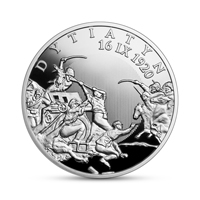
Nominał 20 zł … metal: Ag 925/1000; stempel: lustrzany; średnica: 38,61 mm; masa: 28,28 g; brzeg (bok): gładki; nakład: do 10 000 szt.; Projektant: Urszula Walerzak; Emitent: NBP; Na zlecenie NBP monety wyprodukowała Mennica Polska S.A. Wizerunek fragmentu reprodukcji obrazu Jerzego Kossaka „Bój pod Dytiatynem 16 września 1920” ze zbiorów Muzeum Wojska Polskiego w Warszawie.
Na rewersie monety znajduje się fragment reprodukcji obrazu Jerzego Kossaka „Bój pod Dytiatynem 16 września 1920”. Na awersie wszystkich monet z serii „Polskie Termopile” widnieje Atena, bogini sprawiedliwej wojny i mądrośc.
16 września 1920 r. pod Dytiatynem, na zachód od Podhajec, niewielki oddział polski stoczył bój z dwiema brygadami Armii Czerwonej. Podczas ofensywy polskiej w Galicji 8 Dywizja Piechoty płk. Stanisława Burhardta-Bukackiego otrzymała rozkaz opanowania Podhajec. Rankiem 16 września dwie kompanie III batalionu 13 pułku piechoty kpt. Jana Gabrysia z 4 baterią 1 pułku artylerii górskiej i plutonem 7 baterii 8 pułku artylerii polowej dotarły do Dytiatyna. Zaraz za tą miejscowością żołnierze napotkali kolumny 8 Dywizji Czerwonego Kozactwa i 123 Brygady Strzelców. Polacy przeszli do natarcia, rozproszyli czołowy oddział nieprzyjaciela i zajęli stanowiska na wzgórzu 385. Tam zorganizowali obronę, bowiem marsz bolszewików mógł zagrozić głównym siłom 8 DP. Odparli kilka falowych ataków jazdy i piechoty, wspieranych silnym ogniem artylerii. Gdy zaczęła wyczerpywać się amunicja, zostały uszkodzone dwie armaty i stracono łączność z innymi oddziałami polskimi, około godziny 15 kpt. Gabryś wydał rozkaz odwrotu.
Kiedy większość żołnierzy wycofała się wraz z taborami, bolszewicy zaatakowali stanowiska szykującej się do odmarszu artylerii, osłanianej przez pluton 9 kompanii. Nad grupą artylerzystów i piechurów komendę objął kpt. Adam Zając, dowódca 4 baterii. Raz jeszcze Polacy odrzucili bolszewików i nie odpowiedzieli na propozycję kapitulacji. Podczas kolejnej szarży Kozaków, po wystrzeleniu ostatnich pocisków, bronili armat, walcząc wręcz. Poległo wówczas około pięćdziesięciu polskich żołnierzy, w tym wszyscy oficerowie 4 baterii. Kozacy dobili kilku ciężko rannych wziętych do niewoli. Bitwa pod Dytiatynem na cały dzień zatrzymała marsz dużych sił nieprzyjaciela i uniemożliwiła mu zaatakowanie 8 DP. Przeszła do tradycji Wojska Polskiego jako symbol wypełnionego do końca żołnierskiego obowiązku, została nazwana „polskimi Termopilami” i uwieczniona na tablicach Grobu Nieznanego Żołnierza. Kapitana Zająca odznaczono Virtuti Militari, zaś 4 bateria 1 pułku artylerii górskiej otrzymała nazwę „baterii śmierci”. Dzień 16 września był świętem 1 pułku artylerii motorowej, który zastąpił rozwiązany 1 pułk artylerii górskiej. Informacja: prof. Janusz Odziemkowski.

The Polish Thermopylae – Dytiatyn
www.nbp.pl
Issuing collector items is an occasion to commemorate important historic figures and anniversaries, as well as to develop the interest of the public in Polish culture, science and tradition. Narodowy Bank Polski is the central bank of the State, responsible for its monetary policy and price stability. The Bank’s functions are described in the Constitution of the Republic of Poland and the Act on NBP. NBP holds the exclusive right to issue the currency of the Republic of Poland. As the central bank, it does not provide accounts for the general public, accept deposits from or extend loans to individuals. It acts as a banker to the State budget and public sector entities. NBP also holds and manages the foreign exchange reserves of the State. Finally, it functions as a banker to banks, creating conditions for the operation of the Polish banking system. Narodowy Bank Polski is one of the most important research and analytical centres in the fields of economics and financial markets. On 8 September 2021 Narodowy Bank Polski issued into circulation a silver coin of the series “The Polish Thermopylae” – Dytiatyn, with a face value of 20 złoty.


Face value: 20 zł … Metal: Ag 925/1000; Finish: proof; Diameter: 38.61 mm; Weight: 28.28 g; Edge (side): plain; Mintage: up to 10,000 pcs; Designer: Urszula Walerzak; Issuer: NBP; The coins, commissioned by NBP, were struck by Mennica Polska S.A. An image of a fragment of the reproduction of Jerzy Kossak’s painting “The Battle of Dytiatyn 16 September 1920” from the collection of the Polish Army Museum in Warsaw.
The reverse of the coin depicts a fragment of the reproduction of Jerzy Kossak’s painting “The Battle of Dytiatyn 16 September 1920”. The obverse of all the coins of the “The Polish Thermopylae” series features Athena, the goddess of just war and wisdom.
On 16 September 1920, at Dytiatyn, west of Podhajce, a small Polish unit fought a battle with two brigades of the Red Army. During the Polish offensive in Galicia, the 8th Infantry Division commanded by Col. Stanisław Burhardt-Bukacki received orders to capture Podhajce. In the morning of 16 September, two companies of the 3rd Battalion of the 13th Infantry Regiment, led by Captain Jan Gabryś, with the 4th Battery of the 1st Mountain Artillery Regiment and a platoon of the 7th Battery of the 8th Field Artillery Regiment, reached Dytiatyn. Just outside that village, the soldiers encountered the columns of the 8th Red Cossack Division and the 123rd Rifle Brigade. The Poles moved on to the offensive, dispersed the leading enemy unit and took up positions on Hill 385. There they organised the defence, as the march of the Bolsheviks could threaten the main forces of the 8th ID. They repulsed several wave attacks by cavalry and infantry, supported by heavy artillery fire. At around 3 p.m., as the ammunition started to run out, two cannons had been damaged and communication with other Polish units had been lost, Captain Gabryś gave the order to retreat. As most of the soldiers withdrew with their wagons, the Bolsheviks attacked the artillery positions, which were being prepared to pull back and covered by the 9th Company platoon. Captain Adam Zając, who was leading the 4th Battery, took command of the group of artillerymen and infantrymen.
Once again, the Poles threw back the Bolsheviks and did not respond to an offer to surrender. During another Cossack charge, after the last shells had been fired, they defended the cannons, fighting hand-to-hand. About 50 Polish soldiers, including all the officers of the 4th Battery, died at that time. The Cossacks killed the several seriously wounded who had been taken, prisoner. The battle of Dytiatyn stopped the march of large enemy forces for a whole day and prevented them from attacking the 8th ID. It passed into the tradition of the Polish Army as a symbol of a soldier’s duty fulfilled to the end, was named “the Polish Thermopylae” and immortalised on the plaques of the Tomb of the Unknown Soldier. Captain Zając was decorated with the Virtuti Militari, and the 4th battery of the 1st Mountain Artillery Regiment was given the name of a “dead battery”. The 16th of September was the holiday of the 1st Motorised Artillery Regiment, which replaced the disbanded 1st Mountain Artillery Regiment. Info: Prof. Janusz Odziemkowski.



2021 … Canada Post Community Foundation:
PermanentTM domestic rate stamps + $1 donation
www.canadapost.ca
Support children and youth in our communities with this booklet of 10 PermanentTM domestic rate stamps. Your purchase of this booklet includes a $1 donation which goes directly to the Canada Post Community Foundation. The foundation provides funding to local and national non-profit groups that serve the needs of Canadian children and youth. The annual fundraising stamp augments donations received in local post offices across the country, as well as contributions from internal employee fundraisers during the Canada Post Community Foundation fall campaign.

This stamp features an illustration of fireflies in the night sky, by Kim Smith. The luminous glow of the fireflies is a reminder of the light that shines within each of us. We all have the power to make the world a little brighter for others – especially children and youth. This design was selected by Canada Post front line retail employees, based on their knowledge of customer reactions to the Community Foundation stamp issue.
Support children and youth in our communities with this Official First Day Cover. A donation of 10 cents from this Official First Day Cover goes directly to the Canada Post Community Foundation to fund local and national non-profit groups that spark positive change for children and youth. Our annual – fundraising issue augments donations received in local post offices across the country, as well as contributions from internal employee fundraisers during the Canada Post Community Foundation fall campaign. The stamp is cancelled in Ottawa, Ontario.

This Official First Day Cover features an illustration of fireflies in the night sky, by Kim Smith. The luminous glow of the fireflies is a reminder of the light that shines within each of us. We all have the power to make the world a little brighter for others – especially children and youth.
Stamp Designer: Subplot Design Inc.; Stamp Illustrator: Kim Smith; Issue Date: September 20, 2021; Stamp Value: Permanent™ domestic rate plus the 10-cent surcharge on each stamp; Quantity Produced: 180,000. Good to know … PermanentTM stamps are always worth the going postage rate – no top-up stamps required, ever!

Valour Road: PermanentTM domestic rate stamps
www.canadapost.ca
Celebrate three Canadian Victoria Cross recipients with this booklet of 10 PermanentTM domestic rate stamps from the Valour Road stamp issue. Canada Post has long celebrated Canadian heroes and honoured the bravery and determination of our soldiers. Our stamps feature Canadian courage in battle, our roles as allies in World Wars and in that, our desire for peace.

In this special stamp issue, we honour three Canadian First World War soldiers who were recipients of the seldom-awarded Victoria Cross (Britain’s highest honour for bravery in combat). Each lived on Winnipeg’s Pine Street at one point in their lives: Corporal Lionel (Leo) Clarke, VC, Lieutenant Robert Shankland, VC, DCM, and Company Sergeant Major Frederick William Hall VC. In recognition of the three heroes, Pine Street was officially renamed Valour Road in 1925. A commemorative plaza erected nearby in 2005 features a stone monument in the shape of the Victoria Cross and three steel silhouettes honouring the soldiers of Valour Road. The stamp design features the three heroes, the Victoria Cross medal, the silhouette created to mark their courage, and artistic interpretations of their homes on the former Pine Street. Stamp Designer: Soapbox Design; Stamp Value: Permanent™ domestic rate; Quantity Produced 225,000; Issue Date October 21, 2021.
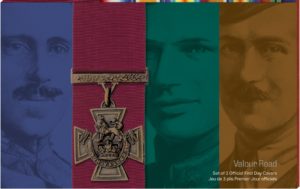
Celebrate three Canadian Victoria Cross recipients with this set of three Official First Day Covers from the Valour Road stamp issue. Each cover design features a portrait of the soldier, and his Victoria Cross and any other medals they received in honour of their service. The packaging folder for the three-part set offers a close-up of the Victoria Cross medal. Victoria Crosses are uniform in the front, with the date of the pertinent incident on the reverse. All three medals are part of the permanent collection of the Canadian War Museum in Ottawa. Cancellation Site: Winnipeg MB; Stamp Designer: Soapbox Design; Stamp Value: Permanent™ domestic rate; Quantity Produced 8,000; Issue Date October 21, 2021.

Celebrate three Canadian Victoria Cross recipients with this pane of 5 PermanentTM domestic rate stamps from the Valour Road stamp issue. The stamp design features the three heroes, the Victoria Cross medal, the silhouette created to mark their courage, and artistic interpretations of their homes on the former Pine Street. Stamp Designer: Soapbox Design; Stamp Value: Permanent™ domestic rate; Quantity Produced: 35,000; Issue Date: October 21, 2021.

The Remembrance Poppy, 100th Anniversary:
PermanentTM domestic rate stamps
www.canadapost.ca
Celebrate Remembrance Day and the 100th Anniversary of the Remembrance Poppy in Canada with this booklet of 10 PermanentTM domestic rate stamps. This stamp issue marks the 100th anniversary of the official adoption of the poppy as a symbol of remembrance in Canada and the launch of the National Poppy Campaign.
The significance of the poppy is said to date back to the Napoleonic Wars in Europe – when the battlefields and resting sites of many fallen soldiers were enriched with lime from the rubble. The chalky soil enabled the poppy (Papaver rhoeas) to thrive before the lime was absorbed. In WWI, the flowers inspired Lieutenant-Colonel John McCrae of Guelph, Ontario, to pen the poem “In Flanders Fields” in May 1915. The poem, in turn, inspired several women and charitable organizations to create fabric poppies as a memorial and to raise funds for veterans and families of the fallen. On July 6, 1921, one of the women, France’s Anna Guérin, proposed that the Great War Veterans’ Association of Canada (now The Royal Canadian Legion) officially adopt the poppy as Canada’s symbol of remembrance. Canada’s first National Poppy Campaign was launched later that year.
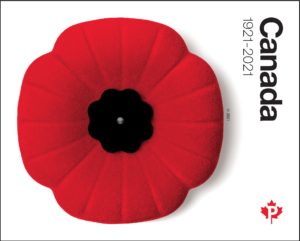
Millions of Canadians show respect and honour for veterans and fallen soldiers during the annual campaign, held in the weeks leading up to Remembrance Day (November 11), by wearing a poppy. Poppies are also often worn at veterans’ funerals and other commemorative events. Stamp Value: Permanent™ domestic rate; Quantity Produced: 250,000; Stamp Designer: Blair Thomson, Believe in; Issue Date October 29, 2021.
Official First Day Cover … Celebrate Remembrance Day and the 100th Anniversary of the Remembrance Poppy in Canada with this FDC. This 2021 stamp issue marks the 100th anniversary of the official adoption of the poppy as a symbol of remembrance in Canada and the launch of the National Poppy Campaign. The Official First Day Cover for this issue features the stamp, set against a crimson red background, and its cancellation mark. The mark includes the number “100” as a nod to the poppy’s centennial as Canada’s official flower of remembrance. Cancellation Site: Ottawa, ON; Stamp Value: Permanent™ domestic rate; Stamp Designer: Blair Thomson, Believe in; Quantity Produced: 8,000; Issue Date: October 29, 2021.

2021 … Pure Silver Coin –
Our National Colours
www.mint.ca
Canada’s arboreal emblem consists of not one but 10 different maples (Acer)species, and that diversity is perfectly illustrated on this 10 oz. pure silver coin. Its engraved design features a clockwise swirl of Canadian maple leaves, each one different from the other and held together by a ribbon that ends in a bow. To top it off, we’ve added selective touches of red and white – Canada’s official colours since 1921 – to transform this Arboreal Anniversary piece into a dual celebration of national symbols.
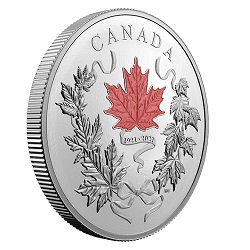
Face value: $100 dollars … Composition: 99.99% pure silver;
Mintage: 800; Finish: proof; Weight: 311.54 g;
Diameter: 76.25 mm; Edge: serrated; Certificate: serialized;
Artist: Michelle Grant (reverse), Susanna Blunt (obverse).
Design: Designed by Canadian artist Michelle Grant, the coin’s reverse features a leaf arrangement representing the 10 native Canadian maple (Acer) species (clockwise): mountain (A. spicatum), red (A. rubrum), striped (A. pensylvanicum), Manitoba (A. negundo), Douglas (A. glabrum), sugar (A. saccharum), big leaf (A. macrophyllum), silver (A. saccharinum), black (A. nigrum) and vine (A. circinatum). Red enamel highlights the sugar maple leaf at the centre; selective frosting adds a touch of white to the ribbon, bow and banner, which bears the dates “1921-2021” to commemorate the 100th anniversary of Canada’s national colours (red and white). The obverse features the effigy of Her Majesty Queen Elizabeth II by Susanna Blunt and a special privy mark in honour of the 25th anniversary (1996-2021) of Canada’s national arboreal emblem, the maple (Acer).
“These maple leaves represent both diversity and unity. Though they all look very different from one another, it amazes me that they still belong to the same species. Their shapes, not only between the species but between individual leaves, are delicate and elegant yet some are more robust, affording a broad range of options for design and movement. These elements are mirrored in our country’s culture, diverse and unified, making me proud to be Canadian.” – Michelle Grant, Artist.
“The colour red is a defining autumn feature of the leaves of many of Canada’s 10 maple species, which perhaps best explains the significance attributed to the maple leaf by Canadians. On the 25th anniversary of the proclamation of the maple genus (Acer) as Canada’s arboreal symbol, it is inspiring to see the leaves of all the 10 Canadian species presented together, in a celebration of Canada’s national colours and national tree.” – Ken Farr, Author of The Forests of Canada.
Did you know? … *** Red and white became our national colours in 1921, as a result of the proclamation of the coat of arms by King George V. Historically, those two colours have also been associated with England and France. *** Among the maples featured on this coin, the black maple (Acer nigrum)is known to cross with the more famous sugar maple (A. saccharum) where their ranges overlap. The striped maple (A. pensylvanicum) and the vine maple (A. circinatum) tend to be overshadowed by other species (literally) – as both are understory trees. And the mountain maple (A. spicatum) holds the distinction of being our smallest maple species, while the Manitoba maple (A. negundo)produces the most distinctive leaf – it’s the only Canadian maple with compound leaves.

2021 … Pure Silver Coin –
The Snowbirds: A Canadian Legacy
www.mint.ca
Formed in 1971 to demonstrate the skill, professionalism and teamwork inherent in the Canadian Forces, the Snowbirds carry on a proud tradition of aerial excellence that dates back to the early years of powered flight in Canada. Their eminent predecessors include aerobatic teams such as the Royal Canadian Air Force’s (RCAF’s) first official aerobatic team in 1929, the Siskins, followed by many others including the Blue Devils, Sky Lancers, Red Knight, Golden Hawks and Golden Centennaires to name a few. In the post-war years prior to unification in 1968, the Royal Canadian Navy (RCN) also formed several aerobatic teams including the Seafire Exhibition Flight and Grey Ghosts. The true significance of the Snowbirds and the legacy they represent can be measured in the hearts and minds of the millions of Canadians who turn their heads skyward year after year to marvel at the team’s grace and precision as they weave their aerial magic across the nation. They continue to be proud ambassadors for the men and women serving in all branches of the Canadian Armed Forces while paying tribute to the thousands of personnel, both military and civilian, who have contributed to their overwhelming success and popularity across North America.

Face value: $50 dollars … Composition: 99.99% pure silver
with selective gold plating;
Mintage: 1,000; Finish: proof; Weight: 157.6 g;
Diameter: 65.25 mm; Edge: serrated; Certificate: serialized;
Artist: Dave O’Malley (reverse), Susanna Blunt (obverse).
Design: Your coin was designed by Canadian graphic artist Dave O’Malley, inspired by a photograph of the Snowbirds taken by Canadian aviation photographer and publisher Mike Reyno. It features a highly-detailed view of the topside of Snowbird 9 and the bottom side of Snowbird 8 revealing the signature “speed bird” design that was introduced by the team in 1974. The engraved “SNOWBIRDS 50” salutes the 50th anniversary of the team in 2021. This unique coin also features beautiful gold plating on both sides designed for the exclusive collector. The effigy of Her Majesty Queen Elizabeth II by Susanna Blunt with “ELIZABETH II”, “D·G·REGINA” and “50 DOLLARS” engraved along the outer edge of the coin is featured on your coin obverse, along with a pattern on the field of a repeated design element taken from the official Snowbirds 50 logo. Project initiative, production liaison and historical text were provided by former Snowbird commander and team leader Dan Dempsey.
Did you know…
*** The genesis of the Snowbirds took place in early 1971 when the Base Commander of CFB Moose Jaw, Saskatchewan, Colonel O.B. Philp, decided to form a seven-plane airshow team to carry on the legacy of the Golden Centennaires which he had commanded in 1967 during Canada’s Centennial Year. Initially flown by instructors at 2 Canadian Forces Flying Training School, the team expanded to nine aircraft in 1972 and soon competitive tryouts were held for pilot volunteers from across Canada, such as the popularity of the new team. The Snowbirds were granted permanent status as a new squadron in the Canadian Forces on April 1, 1978, when they officially became known as the 431 (Air Demonstration) Squadron.
*** Snowbirds pilots are all volunteers, as are the majority of the squadron’s technicians and support staff. Competitive flying tryouts are carried out each year to select new team pilots, with half of the team normally changing each year. Over the years, squadron members have represented every province in Canada and all of Canada’s services – the RCAF, RCN, Canadian Army and the Reserves.
*** Over 150 million spectators across North America have watched a live performance by the Snowbirds over the last 50 years in some 2,700 official airshows at 380 different towns and cities. Hundreds of more flypasts have been flown at every major outdoor event in Canada, from Canada Day on Parliament Hill to the Olympics to the Grey Cup.
*** During their typical six-month airshow season, Snowbirds team members will attend three to four public relations events per week, signing thousands of autographs over the course of the season. The team has a long-established tradition of never leaving an autograph session until every person has received a signed brochure. *** As role models for the youth of Canada, they have proven particularly adept at motivating and inspiring children through school and hospital visits, encouraging them to stay in school, avoid drugs and pursue their dreams, whatever they may be. The Snowbirds are official ambassadors for the CHILD Foundation (children with intestinal and liver disorders), flying a special show for them every summer.

2021 … $200 Pure Gold Coin –
Early Canadian History: The Fur Trade
www.mint.ca
The fourth coin in this series presents a 99.99% pure gold portrait of the fur trade era from the perspective of the Nishiiyuu (Cree). In the fur-rich region of James Bay, the people of Eeyou Istchee (“The People’s Land”) were the skilled hunters, trappers and middlemen who supplied the coveted pelts that were brought to trading posts such as Fort Charles, where they were exchanged for imported goods – metal tools, kettles, cloth and more. Initially, Nishiiyuu and European traders mutually benefitted from this exchange of goods, but as time went on, it proved to be an agent of change. The Nishiiyuu way of subsistence living gradually gave way to a reliance on trade, which was increasingly competitive and led to escalating social problems. The seasonal movement was impeded by the necessity of travelling to the posts. And within the hunting groups that formed the basic unit of society, a new kind of leader emerged – one based on trading and communication skills rather than knowledge of the land. The fur trade shaped this country’s history but it also impacted the traditional ways of the Nishiiyuu, who were important partners and contributors to one of Canada’s earliest industries.
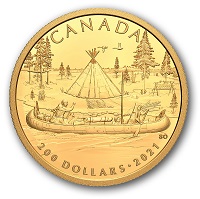
Face value: $200 dollars … Composition: 99.99% pure gold;
Mintage: 1,200; Finish: proof; Weight: 15.43 g;
Diameter: 29 mm; Edge: serrated; Certificate: serialized;
Artist: Sheila Orr (reverse), Susanna Blunt (obverse).
Design: On your coin’s reverse, artist Sheila Orr has created a captivating visual narrative of a Nishiiyuu family departing from their camp, their canoe loaded with supplies for the trip and bundles of furs destined for the trading post. It is springtime in the mid-1700s; the adults are wearing new caribou hide clothing and their child is dressed in a rabbit fur coat. On land, the fish are drying, the food is cached and beaver skulls are hung from a tree as a traditional show of respect. In the sky, the return of migrating geese heralds a new season: summer, a time for gatherings and celebrations. The obverse features the effigy of Her Majesty Queen Elizabeth II by Susanna Blunt.
Did you know? … *** The Nishiiyuu were skilled hunters and gatherers, but they were also adept middlemen: some would exchange their furs for European goods, which were later traded off to other groups that supplied them with more furs.
*** According to Nishiiyuu beliefs, animals make themselves available to the hunters who show proper humility and respect. Remains cannot be carelessly discarded, and as a sign of respect, skulls were traditionally hung in trees – a practice that has been incorporated into this coin’s design.

2021 … Pure Silver Gold-Plated Coin –
Black and Gold: The Grey Wolf
www.mint.ca
The perfect follow-up to our 2019 Black and Gold: The Canadian Horse coin! The duality of the wolf is part of what draws us to it, and the yin and the yang of its existence is what this 99.99% pure silver coin conveys. For centuries, the highly intelligent and social species have been feared and unfairly maligned as the villain in children’s stories. Yet it is that same hunting instinct that makes the elusive wolf an essential part of its ecosystem, where it helps maintain the balance between flora and fauna, predator and prey.

Face value: $20 dollars … Composition: 99.99% pure silver
with yellow gold and black rhodium plating;
Mintage: 4,500; Finish: matte proof; Weight: 31.39 g;
Diameter: 38 mm; Edge: serrated; Certificate: serialized;
Artist: Claude Thivierge (reverse), Susanna Blunt (obverse).
Design: The circular reverse design by Claude Thivierge features a contrasting “yin and yang”- like representation of the grey wolf (Canis lupus). Two wolves are positioned chin-to-chin to illustrate the tight social bonds that exist between pack members and each wolf has fixed its gaze on the viewer. Gold and black rhodium plating perfectly split this engraved image into two opposite but complementary halves. The obverse features the gold-plated effigy of Her Majesty Queen Elizabeth II by Susanna Blunt.
Did you know? … *** Despite its name, the grey wolf’s fur can range from shades of grey and brown to white or even black. You might find a mix of all these colours in a wolf pack. *** Wolves are territorial and they hunt together in packs — in fact, they spend most of their lives in the company of other wolves. Their family bonds are tight, and while they use a wide range of vocalizations and body language to communicate, wolves are known for emitting howls that can be heard several kilometres away.


2021 … $20 Pure Silver Coin –
A Wreath of Remembrance: Lest We Forget
www.mint.ca www.canadapost.ca
On Poppy’s 100th year as a symbol of Remembrance, we offer this wreath to honour those who have served our country and those who continue to help advance peace around the world. Theirs is a legacy of great trials and sacrifice, but also of hope and heroism. We will never forget their bravery, and with this wreath of forget-me-nots and red poppies, we gratefully acknowledge their service while honouring the memory of the fallen.
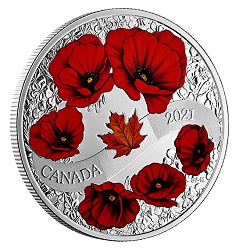
Face value: $20 dollars … Composition: 99.99% pure silver;
Mintage: 7,500; Finish: proof; Weight: 31.39 g;
Diameter: 38 mm; Edge: serrated; Certificate: serialized;
Artist: Caitlin Lindstrom-Milne (reverse); Susanna Blunt (obverse).
Design: The reverse design by Canadian artist Caitlin Lindstrom-Milne is a spiralling wreath arrangement of Remembrance flowers: red-coloured poppies and engraved forget-me-nots. Upon a banner bearing the words “CANADA” and “2021” lies a colourful maple leaf, which symbolizes this nation’s gratitude to all who serve and have served their country throughout Canada’s military history. The obverse features the effigy of Her Majesty Queen Elizabeth II by Susanna Blunt.
“My grandfather was a Second World War veteran so it was crucial that this piece pays tribute to all who served. I wanted to keep the focus on the significance of the Poppy while balancing it with the forget-me-not flowers. But this isn’t your typical symmetrical wreath: from right to left, the different sizes of poppies create a sweeping spiralling motion that results in a looser, more artistic composition. As a tattoo artist, I’m accustomed to my designs carrying a lot of emotional weight for the client and I love seeing how much joy and happiness it brings them. I’m hoping this coin will do the same to those who receive it – that it brings them peace and happiness, and does their loved ones justice by honouring everything they did for us.” Caitlin Lindstrom-Milne, Artist.
Did you know? *** The Poppy has been Canada’s Flower of Remembrance since 1921 when the predecessor of the Royal Canadian Legion adopted it as the official Flower of Remembrance. Today, the red Poppy honours the memory of the more than 118,000 Canadian servicemen and women who lost their lives in the line of duty since Confederation. *** Canada and Newfoundland were separate dominions within the British Empire during the First World War. In the same way, the red Poppy is worn on November 11, a blue flower is worn in Newfoundland and Labrador on July 1, Memorial Day, in fulfilment of the promise to never forget a generation lost at the Battle of Beaumont-Hamel in 1916.


CAPEX 22 Philatelic Societies Invitation
https://capex22.org
CAPEX 22 International One Frame Stamp Championship Exhibition will be held June 9-12, 2022 at the Metro Toronto Convention Centre (MTCC) in the heart of Toronto’s downtown entertainment district. With 400+ frames, CAPEX 22 will be the largest showing of one-frame exhibits at any exhibition, ever.
The exhibition will also have a wonderful array of philatelic literature exhibits both in traditional print format and with four categories of digital literature including philatelic websites. The exhibition’s bourse area will consist of more than 75 Canadian and International dealers, providing a full range of philatelic material for exhibition attendees. CAPEX 22 is being held under the patronage of the Federacion Interamericana de Filatelia (FIAF) and with the recognition of Federation Internationale de Philatélie (FIP).

Exhibition attendees may attend special seminars and other specialist society presentations of interest throughout the four days. Maresch will hold a major auction during the exhibition. The NTSC has booked a meeting room for a presentation during CAPEX 22, and we will share the details closer to the show. Collectors may choose to pre-register for the full four days; daily admissions will also be made available. Registration program information will soon be announced. Feel free to visit the CAPEX 22 website regularly ( www.capex22.org ) to keep up-to-date with all the developments.


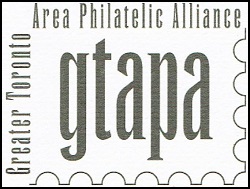
www.gtapa.org
The GTAPA is committed to promote
and stimulate the art of philately to all ages for fun,
culture, education and friendship.

